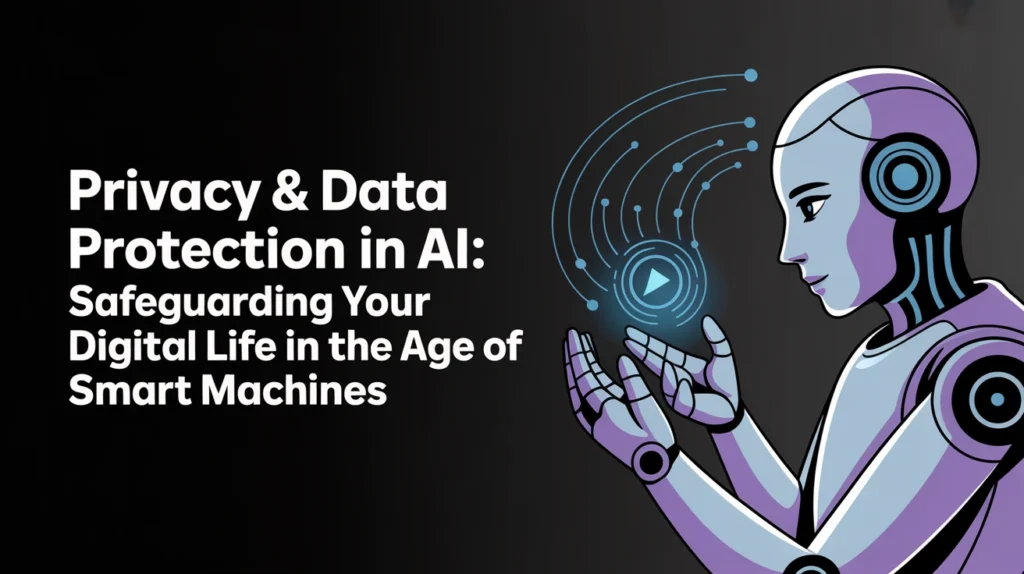Every business leader dreams of a future where their company isn’t just keeping up—but setting the pace. Imagine a business so efficient it seems to run on autopilot; where productivity soars, costs shrink, and growth feels… almost effortless. That’s the promise of a truly AI-driven enterprise.
But here’s the catch: achieving that dream requires more than adopting the latest technology or installing a flashy new tool. It demands a strong foundation—a blueprint designed with care.
Related Post: AI Is Seriously Transforming These Business Areas—Are You Missing Out?
Think of these four pillars as the foundation of your house. Skip one, and the whole structure becomes unstable. Each pillar supports the others, and together they create a solid base for your AI journey. Whether your goal is to outpace the competition, delight your customers, or simply operate smarter and faster, understanding—and building on—these four pillars is your key to a future-ready business.

Let’s dive in and see what holds up the most intelligent, resilient organizations in today’s AI-powered world.
Pillar 1: Strategic Alignment – Making AI Work for Your Business Goals

Every AI project you start should solve a real business problem or help you reach a specific goal. It’s like having a GPS for your AI journey—you need to know where you’re going before you start driving.
Many companies fail because they implement AI just because it sounds cool, not because it helps their business. IBM research shows that companies with strong strategic alignment are 3x more likely to see positive returns from their AI investments.
How to get it right:
Start with Business Problems, Not Technology
Instead of saying “We need AI,” ask yourself:
- What keeps me awake at night about my business?
- Where do we waste the most time or money?
- What would make our customers happier?
- Where do our competitors have an advantage?
Real-world example: A small restaurant chain was struggling with food waste. Instead of jumping into complex AI solutions, they identified their core problem: predicting how much food to prepare each day. They started with a simple AI tool that analyzed past sales, weather patterns, and local events to forecast daily demand. Result? 30% reduction in food waste within six months.
Create Clear Success Metrics
Before starting any AI project, define what success looks like in numbers:
- Cost savings: “Reduce customer service costs by 20%”
- Revenue growth: “Increase online sales by 15%”
- Efficiency gains: “Process invoices 50% faster”
- Customer satisfaction: “Improve response time to under 2 hours”
The Strategic Alignment Checklist:
- Can you explain the business problem in one sentence?
- Do you have specific, measurable goals?
- Will this AI project directly impact your bottom line?
- Does this align with your company’s 3-5 year vision?
- Have you identified who will be responsible for the results?
Pillar 2: Data Readiness – Building Your AI Foundation

Data is like ingredients for cooking. You can have the best chef (AI technology) in the world, but if your ingredients are spoiled, mixed up, or missing, you won’t get a good meal.
Poor data quality is the #1 reason AI projects fail. According to Gartner, companies spend 80% of their AI project time just cleaning and organizing data. Getting this right up front saves massive time and money later.
How to get it right:
Understand What Data You Actually Have
Most businesses collect more data than they realize, but it’s scattered everywhere:
- Customer information in your CRM system
- Sales data in your accounting software
- Website behavior in Google Analytics
- Social media mentions and reviews
- Employee productivity metrics
- Inventory and supply chain data
Action step: Conduct a “data audit.” Spend two weeks mapping out every system where you store information. You’ll be surprised by what you find.
Clean and Organize Your Data
Think of this like organizing your garage before a big project. You need to:
Remove the junk (Data Cleaning):
- Delete duplicate customer records
- Fix spelling errors and inconsistent formatting
- Remove outdated information
- Fill in missing pieces where possible
Organize what’s left (Data Structuring):
- Create consistent naming conventions
- Establish data entry standards
- Set up automatic backups
- Create a single source of truth for key metrics
Real-world example: A mid-size law firm had client information spread across 8 different systems—their website contact forms, intake software, billing system, case management tools, and individual lawyers’ spreadsheets. Before implementing AI for case outcome prediction, they spent 3 months consolidating everything into one system. This “boring” work made their AI project 10x more effective.
Ensure Data Privacy and Security
With great data comes great responsibility. You need to:
- Understand privacy laws that affect your business (GDPR, CCPA, etc.)
- Implement proper access controls (not everyone needs to see everything)
- Create data backup and recovery plans
- Establish clear policies for data sharing and usage
The Data Readiness Checklist:
- Do you know where all your important data lives?
- Is your data accurate and up-to-date?
- Can you easily access and combine data from different sources?
- Do you have proper security measures in place?
- Is your team trained on data privacy requirements?
- Do you have enough historical data to train AI models effectively?
Pillar 3: Talent & Culture – Building Your AI-Ready Team
You don’t need to hire a bunch of data scientists, but you do need people who understand how AI can help your business and aren’t afraid to try new things.

The best AI technology in the world is useless if your team doesn’t know how to use it or is resistant to change. McKinsey research shows that companies with strong AI culture see 2x better results from their AI investments.
How to get it right:
Build AI Literacy Across Your Organization
Everyone doesn’t need to be an expert, but they should understand the basics:
For Leadership:
- What AI can and cannot do for your industry
- How to evaluate AI vendors and solutions
- Basic understanding of data privacy and AI ethics
- How to set realistic expectations and timelines
For Managers:
- How AI might change their team’s daily work
- How to identify processes that could benefit from AI
- Basic project management for AI initiatives
- How to support their team through AI-related changes
For Front-line Employees:
- How AI tools can make their jobs easier, not replace them
- Basic data hygiene and quality practices
- How to provide feedback on AI tool performance
- Understanding of privacy and security best practices
Real-world example: A regional bank started its AI journey not with technology, but with education. They created a monthly “AI Coffee Hour” where employees could ask questions and share ideas about how AI might help their specific roles. This grassroots approach led to 50+ practical AI use cases identified by employees themselves, from automating loan paperwork to personalizing customer communications.
Strategic Hiring and Upskilling
You have three options for building AI capabilities:
Option 1: Hire AI Specialists
- Data scientists for complex analytics
- AI/ML engineers for technical implementation
- AI product managers to bridge business and technology
Option 2: Upskill Existing Employees
- Send key staff to AI training programs
- Partner with local universities for executive education
- Invest in online learning platforms focused on business AI applications
Option 3: Hybrid Approach (Recommended)
- Hire a few key AI experts to lead initiatives
- Train existing employees to work effectively with AI tools
- Use external consultants for specialized projects
Foster a Culture of Experimentation
AI requires a “test and learn” mindset:
- Encourage small experiments and pilot projects
- Celebrate learning from failures, not just successes
- Create safe spaces to try new approaches
- Share success stories across the organization
- Reward curiosity and creative problem-solving
The Talent & Culture Checklist:
- Does your leadership team understand AI’s potential and limitations?
- Do you have at least one person dedicated to driving AI initiatives?
- Are your employees excited about AI, or fearful of it?
- Do you have processes for continuous learning and skill development?
- Can your team effectively collaborate with external AI vendors or consultants?
- Do you celebrate both successes and intelligent failures?
Pillar 4: Change Management – Making AI Adoption Smooth and Successful
Change management is about helping people transition from old ways of working to new AI-powered processes. It’s the difference between AI tools sitting unused and becoming integral to your business success.
Even the most brilliant AI solution will fail if people don’t adopt it. Research from MIT shows that 70% of AI projects fail not because of technical issues, but because of poor change management.
How to get it right:
Start with Communication and Transparency
People fear what they don’t understand. Clear, honest communication is essential:
What to communicate:
- Why you’re implementing AI (business benefits, not just because it’s trendy)
- How will it affect different roles and departments
- What training and support will be provided
- Timeline for implementation and key milestones
- How success will be measured
How to communicate:
- Regular all-hands meetings with Q&A sessions
- Department-specific briefings addressing role-specific concerns
- Internal newsletters or blog posts sharing progress updates
- One-on-one conversations between managers and their teams
- Anonymous feedback channels for concerns and suggestions
Real-world example: A manufacturing company implementing predictive maintenance AI created a series of “Lunch and Learn” sessions where engineers explained how the AI would help maintenance workers spot problems earlier, making their jobs safer and more interesting. They addressed fears head-on, showing that the AI was a tool to enhance human expertise, not replace it.
Address Resistance Proactively
Resistance is natural and often comes from legitimate concerns:
Common sources of resistance:
- Fear of job loss or skill obsolescence
- Concern about making mistakes with new technology
- Skepticism about AI effectiveness
- Comfort with existing processes
- Lack of confidence in leadership’s technology decisions
How to address resistance:
- Listen actively to concerns and validate them
- Provide concrete examples of how AI will improve daily work
- Create “AI champions” within each department
- Offer additional training and support for hesitant adopters
- Show quick wins and celebrate early successes
- Be patient—adoption takes time
Design for User Adoption
Make AI tools as easy to use as possible:
User-friendly design principles:
- Intuitive interfaces that don’t require extensive training
- Integration with existing tools and workflows
- Clear instructions and help documentation
- Responsive customer support for technical issues
- Regular user feedback collection and system improvements
Create Feedback Loops and Continuous Improvement
AI systems get better over time, but only with human guidance:
Establish feedback mechanisms:
- Regular user surveys about AI tool effectiveness
- Weekly team check-ins to discuss AI-related challenges
- Quarterly reviews of AI project outcomes
- Anonymous suggestion boxes for improvements
- Cross-departmental meetings to share best practices
Act on feedback:
- Prioritize the most common user requests
- Communicate what changes are being made and why
- Celebrate improvements that came from user suggestions
- Keep the feedback loop active and responsive
Measure and Communicate Success
People need to see that AI is actually working:
Track both quantitative and qualitative metrics:
- Quantitative: Cost savings, efficiency gains, error reduction, revenue growth
- Qualitative: Employee satisfaction, customer feedback, process improvements
Share success stories regularly:
- Monthly newsletters highlighting AI wins
- Case studies showing before-and-after comparisons
- Employee testimonials about how AI has helped their work
- Customer success stories related to AI improvements
The Change Management Checklist:
- Do you have a clear communication plan for AI implementation?
- Have you identified and addressed potential sources of resistance?
- Are your AI tools designed with user adoption in mind?
- Do you have systems in place to collect and act on user feedback?
- Are you measuring and sharing both the business and human impact of AI?
- Do you have change champions throughout your organization?
- Is your leadership visibly committed to the AI transformation?
Bringing It All Together: Your AI Strategy Roadmap
These four pillars work together to create sustainable AI success:
- Strategic Alignment ensures you’re solving the right problems
- Data Readiness provides the foundation for effective AI
- Talent & Culture gives you the people and mindset to succeed
- Change Management ensures smooth adoption and continuous improvement
Remember: You don’t have to perfect all four pillars before starting. Begin with small, manageable projects that touch on each pillar, learn from the experience, and gradually expand your AI capabilities.
The key is to think of AI strategy not as a one-time project, but as an ongoing journey of business transformation. Start where you are, use what you have, and take the next small step forward.






